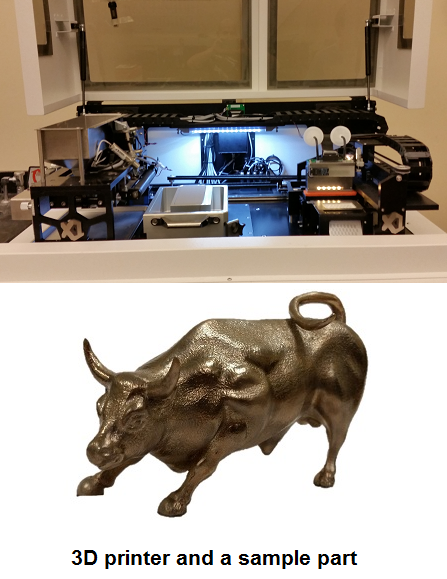Effective Deposition and Spreading of Powder Layers for 3D Printing
Nathan Crane, Associate Professor
Department of Mechanical Engineering
University of South Florida, Tampa, Florida 33620
crane@usf.edu; 813-974-8586
Overview of the Crane Research Group
Professor Crane's Micro-Integration Lab is working on developing and improving advanced manufacturing and integration processes. Dr. Crane has over a decade of experience in additive manufacturing (3D printing) process development including binder jetting, laser sintering, and direct write. Current 3D printing project activities include developing methods for assessing reliability and quality in multi-material components, developing new methods for processing metal components, and high-rate polymer sintering.
 The lab's work addresses manufacturing process challenges in a variety of fields from antennas to thermoelectrics. Many projects are related to surface tension effects in manufacturing processes. Examples include capillary self-assembly, electrowetting microactuation, and inkjet printing in Additive Manufacturing.
The lab's work addresses manufacturing process challenges in a variety of fields from antennas to thermoelectrics. Many projects are related to surface tension effects in manufacturing processes. Examples include capillary self-assembly, electrowetting microactuation, and inkjet printing in Additive Manufacturing.
Teacher Project:
3D printing (additive manufacturing) has opened many new opportunities to quickly create unique products and geometries at low cost. These advances have revolutionized product development and are increasingly enabling new products and entire businesses that are built on the ability to fabricate unique geometries quickly. This has been particular impactful in medical devices (prosthetics, implants) and aerospace.
Many 3D printing processes utilize powder feedstock that is then selectively fused together to form the components. The quality of the final components depends on the uniformity and density of the powder layers that are deposited. This can be affected by powder properties (density, particle size, particle shape) environmental effects (ambient humidity), powder coatings, and process parameters (layer thickness, vibration settings, printing parameters). Effective development and deployment of new processing methods requires increased understanding of how these and other variables effect the powder handling.
During this project, the teacher will learn to operate a 3D printer, prepare parts for printing, and to post process the parts. They will also learn to test the density of the powder bed and the strength of the printed parts. The teacher will start by learning the basics of 3D printing using standard thermal extrusion systems. They will then receive training on using our research systems. A graduate student mentor will work with the teacher will then work to develop and implement a test strategy. This will include fabrication of test parts and evaluation of their properties.
- 1. Upconversion Photocatalysis for Energy and Environmental Applications
- 2. Sorption of Organic Vapors by Polymers using a Quartz Crystal Microbalance
- 3. Effective Deposition and Spreading of Powder Layers for 3D Printing
- 4. Synthesis and Characterization of Structured Nanomaterials for Energy Applications
- 5. Syntheses and Characterizations of Catalytically Active Porous Metal-Organic Frameworks (MOFs)
- 6. Microfluidic Filtration of Circulating Tumor Cells
- 7. Simulation and Rational Design of Metal-Organic Materials
- 8. Composition of Organic and Inorganic Polymeric Nanofibers for Filtering, Tissue Scaffolding, Wavelength Reflecting, and Self-healing Functionalities
- 9. Dynamic Tissue Cultures for Cell Printing
- 10. Synthesis and Characterization of Nanocomposites for 3D Printed RF Devices